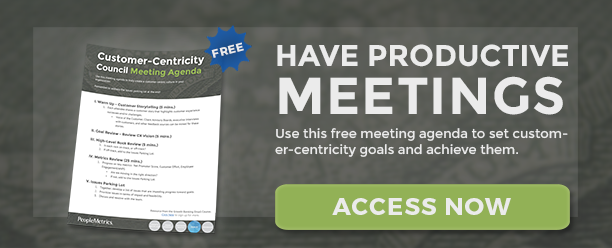From business books to classic literature, much has been written about the necessity of visualizing your destination and defining your target. Take, for example, this classic back-and-forth between Alice and the Cheshire Cat:

If you're trying to achieve growth for your bank, it should come as no surprise that you need to set clear goals for improving customer experience. As a leader at your bank, you're responsible for defining the destination and setting the direction. But how? What are good goals when it comes to customer centricity? How can you ensure you're progressing as you need to?
Here's some good news! We've broken it down into five steps to follow to define your customer experience improvement goals:
1. Clearly and specifically define the destination.
The first step of setting goals around the customer experience is defining what success will look like. For example, when you achieve success, will you have more customers in general? Will you have more customers of one type than another? In terms of your offerings, will those customers be interacting with more or fewer products than today?
Perhaps your destination is based on perception. Will you be successful when you're considered a best bank to do business with? When you're a best bank to work for?
Or maybe it's a matter of streamlining operations. Does success mean closing lagging branches while retaining and growing the existing customer base?
The more specific you can be about your future success, the more you'll be in a situation to achieve it. And the less likely you'll get lost along the way.

2. Choose your metrics.
Once you have a clear vision of your destination, the next step is figuring out how to measure your progress toward it. It's important to choose focused and clear metrics, to ensure that leadership and employees know what to focus on. By communicating that you're trying to move specific needles, you'll make day-to-day decision making much simpler for everyone involved.
And that will make your bank much more capable of reaching your ultimate goals.
Depending on your destination, your key metrics may be the net new customers per month or quarter, your JD Power ranking, or the change in household product penetration. Whatever the case, make the metrics specific, and keep in mind that fewer metrics means less distraction and more doing.

3. Set quarterly rocks that tie to goals.
To further keep everyone focused on achieving goals, create quarterly "rocks," ambitious progress milestones for your goals. These will allow you to keep tabs on success, as well as make adjustments to your overall strategy. (If, say, you are either wonderfully ahead or *cough* painfully behind.) Here are some questions to help:
- What has to happen this quarter to get us closer to our target goal?
- What initiative will help us to capture more customers?
- What actions will better improve our JD Power ranking?
- What are we doing to increase the number of products each of our customers holds with our bank?
- What can we do to achieve our definition of success?
4. Get disciplined about reviewing progress and updating your rocks.
Rocks aren't particularly useful if you don't measure yourself against them. Make it a point to review progress methodically and often. When you're meeting with your team, make sure to hold people accountable for their part that influences achievement of the goal. Also meet regularly to track the indicators that ensure progress.
We recommend monthly review meetings with longer quarterly business planning sessions, to make sure you're on track.

5. Be prepared to revise and adapt your plan in order to reach the destination.
Bringing plans to life is best done with a large grain of salt. The real world has a funny way of finding flaws in even the most-thorough plans. As such, be prepared to make adjustments as needed.
This is where keeping track of numbers that indicate the success—or failure—of your current initiatives will help. You'll have data to inform your decisions as you adapt to get closer to the goal.
Learn More
Discussing progress and the need to adapt should be part of your regular review meetings. That's why we've created a FREE meeting agenda to help with your ongoing goal setting and improvement efforts. Just click the image below to get your copy.
If you'd like to talk more about goal setting, or would like to get more information about how we can help you achieve your customer experience strategy, then contact us. We'd be happy to talk.






%20(1).png)